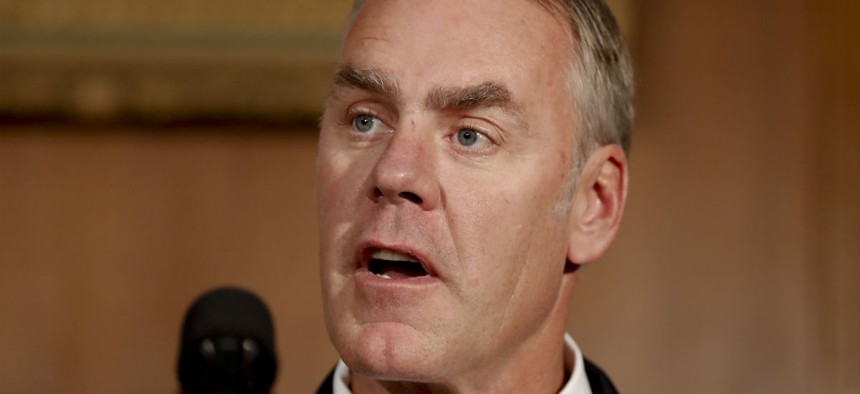
Interior Secretary Ryan Zinke has said the Senior Executive Service "by definition gets moved." Carolyn Kaster/AP
The 'Chilling Effect' of Forced Reassignments at Trump's Interior Dept.
Interior argues reassignments are normal for SES, not retaliation.
The Interior Department denied it did anything outside the normal order of business when it transferred a senior executive with a background in science to an accounting position, despite a high-profile claim of whistleblower retaliation from the employee.
Joel Clement served as the director of the Office of Policy Analysis at Interior until he was reassigned last week to a senior adviser position in the Office of Natural Resources Revenue. On Wednesday, Clement penned an op-ed in the Washington Post claiming the reassignment to an accounting position was involuntary and in retaliation for his speaking out on the risks climate change posed to Alaska Native populations. He filed a complaint on the alleged reprisal to the Office of Special Counsel, which handles cases involving potential whistleblower retaliation, and a disclosure to OSC about the potential dangers of eliminating his former position.
In June testimony before the Senate Appropriations Committee, Interior Secretary Ryan Zinke told lawmakers he planned to shed 4,000 employees through “a combination of attrition, reassignments and separation incentives.” To Clement, that amounted to an open admission Interior had reassigned him in hopes that he would simply quit. Zinke went on to say at the hearing, however, that the Senior Executive Service “by definition gets moved.” He added that all the supervisors had the choice of whether to relocate.
Heather Swift, an Interior spokeswoman, elaborated that Zinke has been “absolutely out front” that departmental reorganization would be a staple of his tenure as secretary. She added the purpose of the SES is to ensure a management corps “responsive to the needs, policies and goals of the nation.”
“Senior executives are the highest paid employees in the federal government and signed up for the SES knowing that they could be called upon to work in different positions at any time,” Swift said. “Congress meant for the SES to be a mobile force that is capable of taking on different assignments to meet the needs of the agency.”
In an interview with Government Executive, Clement acknowledged there is a legitimate purpose for reassigning senior executives -- President Obama prioritized SES job rotations in an executive order issued late in his tenure -- but not when used for retaliation. Clement disputed that the reassignment was voluntary, saying he had to accept the new position or resign from his job. He added it has resulted in a “profound chilling effect” on his staff.
“They were really freaked out after my reassignment,” Clement said. Of the department writ large, he added, “Walking into that place is like walking into a morgue. People are looking over their shoulders wondering if they’re next.”
Swift said the personnel moves -- nearly 50 of Interior’s roughly 225 SES employees have been reassigned -- were designed “to better serve the taxpayer and the department’s operations.” She declined to discuss the details of Clement’s accusations.
“The department does not comment on ongoing matters such as whistleblower complaints,” Swift said. “We look forward to working with the Office of Special Counsel to address any questions they might have about this matter.”
She also declined to comment on whether the department believes that climate change is having a harmful impact on Native Alaskans.
Debra D’Agostino, a founding partner at The Federal Practice Group who represents employees in whistleblower retaliation cases, said she expects Clement to prevail. While Interior will argue it has the right to reassign SES employees, she said, the government cannot do so with an “impermissible motive.”
According to Clement’s op-ed, that is exactly what occurred.
“The Trump administration didn’t think my years of science and policy experience were better suited to accounts receivable,” he wrote. “It sidelined me in the hope that I would be quiet or quit.”
Whistleblower retaliation through reassignment is a common governmental tactic dating back to the Ronald Reagan administration, she explained, in which agencies send employees to positions where they “end up sitting in the corner twiddling their thumbs.”
Clement will first have to demonstrate he made a protected disclosure under the Whistleblower Protection Act, which D’Agostino said he likely did by speaking out about a substantial threat to public health and safety. His case will then have to pass what is known as the “timing test,” meaning Clement will have to demonstrate the people that reassigned him knew about his disclosure and acted subsequent to obtaining that knowledge. Interior will then have to prove it would have made the same decision if Clement had never made the disclosure, which D’Agostino speculated is where the Trump administration’s argument will begin to fall apart.
“I can’t fathom the agency is going to be able to put something up other than, ‘Well, we have the right,’ ” she said. “It’s not something that makes sense to any reasonable person.”
Clement said he has received a “groundswell of support” from federal employees across the government since he published the op-ed on Wednesday. He has yet to hear from any Interior political appointees, but civil servants around the country have thanked him for speaking out and said they now feel empowered. Clement had hoped to encourage other federal employees to speak out, he said, because their work could suffer without their advocacy.
For now, Clement has decided to take a couple days of leave “while things settle down.” He will await the outcome of his OSC complaint and expects to hear from his supervisor eventually as to whether anything will be different when he returns.
“I’ll be prepared to remain a civil servant,” Clement said, “and hope I have a meaningful role.”







